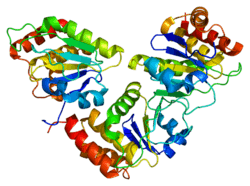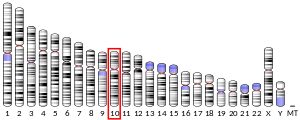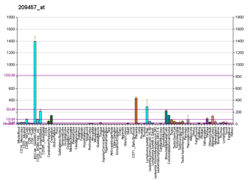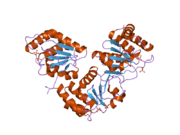DUSP5
Dual specificity protein phosphatase 5 is an enzyme that in humans is encoded by the DUSP5 gene.[5][6]
Function
The protein encoded by this gene is a member of the dual specificity protein phosphatase subfamily. These phosphatases inactivate their target kinases by dephosphorylating both the phosphoserine/threonine and phosphotyrosine residues. They negatively regulate members of the mitogen-activated protein (MAP) kinase superfamily (MAPK/ERK, SAPK/JNK, p38), which are associated with cellular proliferation and differentiation. Different members of the family of dual specificity phosphatases show distinct substrate specificities for various MAP kinases, different tissue distribution and subcellular localization, and different modes of inducibility of their expression by extracellular stimuli. This gene product inactivates ERK1/2, is expressed in a variety of tissues with the highest levels in pancreas and brain, and is localized in the nucleus.[6]
Model organisms
Model organisms have been used in the study of DUSP5 function. A conditional knockout mouse line called Dusp5tm1a(KOMP)Wtsi was generated at the Wellcome Trust Sanger Institute.[7] Male and female animals underwent a standardized phenotypic screen[8] to determine the effects of deletion.[9][10][11][12] Additional screens performed: - In-depth immunological phenotyping[13]
| Characteristic | Phenotype |
|---|---|
| Insulin | Normal |
| Homozygous viability at P14 | Normal |
| Homozygous Fertility | Normal |
| Body weight | Normal |
| Neurological assessment | Normal |
| Grip strength | Normal |
| Dysmorphology | Normal |
| Indirect calorimetry | Normal |
| Glucose tolerance test | Normal |
| Auditory brainstem response | Normal |
| DEXA | Normal |
| Radiography | Normal |
| Eye morphology | Normal |
| Clinical chemistry | Normal |
| Haematology 16 Weeks | Normal |
| Peripheral blood leukocytes 16 Weeks | Normal |
| Heart weight | Normal |
| Salmonella infection | Normal |
| Spleen Immunophenotyping | Normal |
| Epidermal Immune Composition | Normal |
References
- GRCh38: Ensembl release 89: ENSG00000138166 - Ensembl, May 2017
- GRCm38: Ensembl release 89: ENSMUSG00000034765 - Ensembl, May 2017
- "Human PubMed Reference:". National Center for Biotechnology Information, U.S. National Library of Medicine.
- "Mouse PubMed Reference:". National Center for Biotechnology Information, U.S. National Library of Medicine.
- Martell KJ, Kwak S, Hakes DJ, Dixon JE, Trent JM (Jul 1994). "Chromosomal localization of four human VH1-like protein-tyrosine phosphatases". Genomics. 22 (2): 462–4. doi:10.1006/geno.1994.1411. hdl:2027.42/31442. PMID 7806236.
- "Entrez Gene: DUSP5 dual specificity phosphatase 5".
- Gerdin AK (2010). "The Sanger Mouse Genetics Programme: high throughput characterisation of knockout mice". Acta Ophthalmologica. 88: 925–7. doi:10.1111/j.1755-3768.2010.4142.x.
- "International Mouse Phenotyping Consortium".
- Skarnes WC, Rosen B, West AP, Koutsourakis M, Bushell W, Iyer V, Mujica AO, Thomas M, Harrow J, Cox T, Jackson D, Severin J, Biggs P, Fu J, Nefedov M, de Jong PJ, Stewart AF, Bradley A (Jun 2011). "A conditional knockout resource for the genome-wide study of mouse gene function". Nature. 474 (7351): 337–42. doi:10.1038/nature10163. PMC 3572410. PMID 21677750.
- Dolgin E (Jun 2011). "Mouse library set to be knockout". Nature. 474 (7351): 262–3. doi:10.1038/474262a. PMID 21677718.
- Collins FS, Rossant J, Wurst W (Jan 2007). "A mouse for all reasons". Cell. 128 (1): 9–13. doi:10.1016/j.cell.2006.12.018. PMID 17218247.
- White JK, Gerdin AK, Karp NA, Ryder E, Buljan M, Bussell JN, Salisbury J, Clare S, Ingham NJ, Podrini C, Houghton R, Estabel J, Bottomley JR, Melvin DG, Sunter D, Adams NC, Tannahill D, Logan DW, Macarthur DG, Flint J, Mahajan VB, Tsang SH, Smyth I, Watt FM, Skarnes WC, Dougan G, Adams DJ, Ramirez-Solis R, Bradley A, Steel KP (Jul 2013). "Genome-wide generation and systematic phenotyping of knockout mice reveals new roles for many genes". Cell. 154 (2): 452–64. doi:10.1016/j.cell.2013.06.022. PMC 3717207. PMID 23870131.
- "Infection and Immunity Immunophenotyping (3i) Consortium".
Further reading
- Robertson NG, Khetarpal U, Gutiérrez-Espeleta GA, Bieber FR, Morton CC (Sep 1994). "Isolation of novel and known genes from a human fetal cochlear cDNA library using subtractive hybridization and differential screening". Genomics. 23 (1): 42–50. doi:10.1006/geno.1994.1457. PMID 7829101.
- Kwak SP, Dixon JE (Jan 1995). "Multiple dual specificity protein tyrosine phosphatases are expressed and regulated differentially in liver cell lines". The Journal of Biological Chemistry. 270 (3): 1156–60. doi:10.1074/jbc.270.3.1156. PMID 7836374.
- Ishibashi T, Bottaro DP, Michieli P, Kelley CA, Aaronson SA (Nov 1994). "A novel dual specificity phosphatase induced by serum stimulation and heat shock". The Journal of Biological Chemistry. 269 (47): 29897–902. PMID 7961985.
- Ueda K, Arakawa H, Nakamura Y (Aug 2003). "Dual-specificity phosphatase 5 (DUSP5) as a direct transcriptional target of tumor suppressor p53". Oncogene. 22 (36): 5586–91. doi:10.1038/sj.onc.1206845. PMID 12944906.
- Mandl M, Slack DN, Keyse SM (Mar 2005). "Specific inactivation and nuclear anchoring of extracellular signal-regulated kinase 2 by the inducible dual-specificity protein phosphatase DUSP5". Molecular and Cellular Biology. 25 (5): 1830–45. doi:10.1128/MCB.25.5.1830-1845.2005. PMC 549372. PMID 15713638.
- Jeong DG, Cho YH, Yoon TS, Kim JH, Ryu SE, Kim SJ (Jan 2007). "Crystal structure of the catalytic domain of human DUSP5, a dual specificity MAP kinase protein phosphatase". Proteins. 66 (1): 253–8. doi:10.1002/prot.21224. PMID 17078075.
- Sarközi R, Miller B, Pollack V, Feifel E, Mayer G, Sorokin A, Schramek H (Apr 2007). "ERK1/2-driven and MKP-mediated inhibition of EGF-induced ERK5 signaling in human proximal tubular cells". Journal of Cellular Physiology. 211 (1): 88–100. doi:10.1002/jcp.20909. PMID 17131384.
External links
- Overview of all the structural information available in the PDB for UniProt: Q16690 (Dual specificity protein phosphatase 5) at the PDBe-KB.






